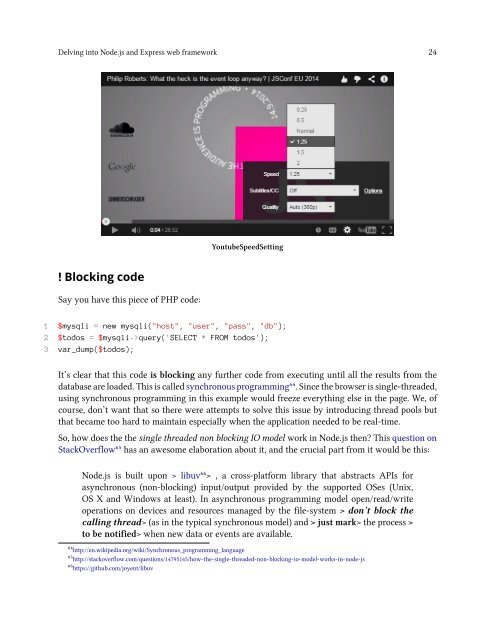Mittwoch, 18. Mai, 2016
Create successful ePaper yourself
Turn your PDF publications into a flip-book with our unique Google optimized e-Paper software.
Delving into Node.js and Express web framework 24<br />
YoutubeSpeedSetting<br />
! Blocking code<br />
Say you have this piece of PHP code:<br />
1 $mysqli = new mysqli("host", "user", "pass", "db");<br />
2 $todos = $mysqli->query('SELECT * FROM todos');<br />
3 var_dump($todos);<br />
It’s clear that this code is blocking any further code from executing until all the results from the<br />
database are loaded. This is called synchronous programming⁶⁴. Since the browser is single-threaded,<br />
using synchronous programming in this example would freeze everything else in the page. We, of<br />
course, don’t want that so there were attempts to solve this issue by introducing thread pools but<br />
that became too hard to maintain especially when the application needed to be real-time.<br />
So, how does the the single threaded non blocking IO model work in Node.js then? This question on<br />
StackOverflow⁶⁵ has an awesome elaboration about it, and the crucial part from it would be this:<br />
Node.js is built upon > libuv⁶⁶> , a cross-platform library that abstracts APIs for<br />
asynchronous (non-blocking) input/output provided by the supported OSes (Unix,<br />
OS X and Windows at least). In asynchronous programming model open/read/write<br />
operations on devices and resources managed by the file-system > don’t block the<br />
calling thread> (as in the typical synchronous model) and > just mark> the process ><br />
to be notified> when new data or events are available.<br />
⁶⁴http://en.wikipedia.org/wiki/Synchronous_programming_language<br />
⁶⁵http://stackoverflow.com/questions/14795145/how-the-single-threaded-non-blocking-io-model-works-in-node-js<br />
⁶⁶https://github.com/joyent/libuv
















